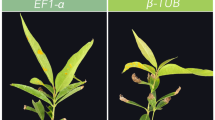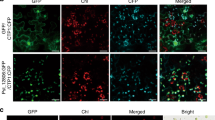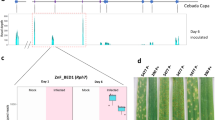Abstract
REMARKABLE changes in the levels and properties of ribonuclease (RNase) occur following the inoculation of a susceptible variety of flax (Linum usitatissimum L., var. Bison) with flax rust uredospores (Melampsora lini (Ehrenb.) Lev, race 3)1. The increase in RNase activity occurs in two distinct phases; an early phase between 2 to 4 d after inoculation (early RNase) and a later phase, beginning 5 d after inoculation (late RNase). These increases in RNase activity are accompanied by substantial changes in the properties of the enzyme including thermal stability, diethyl-pyrocarbonate-sensitivity and substrate preference1. Further studies (A. K. C., M. S., and L. A. S., unpublished) have revealed that these changes in the properties of RNase are due, at least in part, to the formation of new RNase molecules. These have kinetic and catalytic properties that are quite distinct from both of those ‘host’ RNase from healthy flax cotyledons and ‘rust’ RNase from flax rust uredospores or from rust mycelium grown axenically in a chemically defined medium. That changes in late RNase activity are specifically elicited by compatible host-parasite interactions is indicated by the appearance of late RNase which is not detectable in a resistant variety of flax (Bombay) inoculated with race 3 of Melampsora lini1. Furthermore, the characteristic bimodal increase in RNase activity and the accompanying changes in various properties of the enzyme have been found in a number of other rust-infected plants including pine and Ribes (A. E. Harvey, A. K. C., M. S. and L. A. S., unpublished), and mechanical injury of the healthy host tissues causes a significant increase in the level of RNase. The enzyme remains strictly ‘host-type’, however, no change in its physical or catalytic properties being detectable (ref. 1 and A. E. Harvey, A. K. C., M. S., and L. A. S., unpublished). Here we describe the effect of inoculation with uredospores of three races (56, 56A and Australian race 126 ANZ-6, 7) of wheat stem rust (Puccinia graminis (Pers.) f. sp. tritici Eriks. and E. Henn.) in causing quantitative and qualitative changes in the RNase activity of paired, near-isogenic lines of wheat (Triticum aestivum L.) derived from the variety Chinese Spring and carrying the alleles Sr6 and sr6 (refs 2 and 3), respectively. Both lines give susceptible reactions (infection type 4 (ref. 4)) with race 56A, independent of temperature. The homozygous recessive, sr6, imparts susceptibility (infection type 4) to races 56 and 126 ANZ-6, 7. The dominant allele, Sr6, confers a temperature sensitive reaction to these races; resistance is expressed (infection type 0 (ref. 4)) at 19 to 21° C but breaks down (infection type 4) at higher temperatures (25 to 26° C). A few intercellular hyphae are produced at each infection site at 19 to 21° C. These survive for several days and resume growth when infected plants are transferred to 25 to 26° C; but, in our experience, the longer infected plants are held at 19 to 21° C before transfer, the smaller are the number and size of the sporulating pustules to be developed.
This is a preview of subscription content, access via your institution
Access options
Subscribe to this journal
Receive 51 print issues and online access
$199.00 per year
only $3.90 per issue
Buy this article
- Purchase on Springer Link
- Instant access to full article PDF
Prices may be subject to local taxes which are calculated during checkout
Similar content being viewed by others
References
Scrubb, L. A., Chakravorty, A. K., and Shaw, M., Pl. Physiol. 50, 73 (1972).
Loegering, W. Q., and Harmon, D. L., Phytopathology 59, 456 (1969).
Seevers, P. M., and Daly, J. M., Phytopathology 60, 1322 (1970).
Stakman, E. C., Stewart, D. M., and Loegering, W. Q., Identification of physiologic races of Puccinia graminis var. trictica, E 617 (USDA Publication, 1962).
Williams, P. G., Scott, K. G., Kuhl, J. L., and MacLean, D. J., Phytopathology, 57, 236 (1967).
Bose, A., and Shaw, M., Can. J. Bot., 49, 1961 (1971).
Rohringer, R., and Heitefuss, R., Can. J. Bot., 39, 263 (1961).
Chakrovorty, A. K., and Shaw, M., Biochem. J., 123, 551 (1971).
Chakravorty, A. K., Biochim. biosphy. Acta, 179, 67 (1969).
Author information
Authors and Affiliations
Rights and permissions
About this article
Cite this article
CHAKRAVORTY, A., SHAW, M. & SCRUBB, L. Ribonuclease activity of wheat leaves and rust infection. Nature 247, 577–580 (1974). https://doi.org/10.1038/247577b0
Received:
Issue Date:
DOI: https://doi.org/10.1038/247577b0
This article is cited by
-
Ribonuclease and proteinase activities in potato leaves immunized against Phytophthora infestans
Acta Physiologiae Plantarum (2001)
-
Isolation and characterization of cDNAs encoding xylogenesis-associated and wounding-induced ribonucleases in Zinnia elegans
Plant Molecular Biology (1996)
-
Chromosomal locations of genes that control major RNA-degrading activities in common wheat (Triticum aestivum L.)
Theoretical and Applied Genetics (1996)
-
Identification, characterization, and comparison of RNA-degrading enzymes of wheat and barley
Biochemical Genetics (1993)
-
Identification, characterization, and comparison of RNA-degrading enzymes of wheat and barley
Biochemical Genetics (1993)
Comments
By submitting a comment you agree to abide by our Terms and Community Guidelines. If you find something abusive or that does not comply with our terms or guidelines please flag it as inappropriate.



